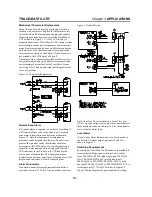
TRACE
MATE II-CTR
Chapter 4 Operation
4.1
Alarms
There are totally 5 types of alarm in TraceMate II-CTR.
They are listed below.
RTD Fail: If the RTD sensor is not connected or shorted,
an RTD Fail alarm occurs. Check that the RTD sensor is
properly connected. This alarm is not latched and will be
reset as soon as the RTD is properly connected. In the
event of an RTD failure, the heater output is turned off to
prevent a runaway heating situation.
Low Temperature: Once the actual temperature is below
the low temperature alarm setpoint, a Low Temperature
alarm occurs. This will normally indicate that the heater
circuit is not providing enough heat to maintain the
setpoint. When a system is first turned on this alarm may
be activated. It is particularly useful in taking corrective
action in freeze protection systems to prevent a burst
pipe. This alarm is not latched and will be reset as soon as
the alarm condition disappears.
High Temperature: Once the actual temperature is above
the high temperature alarm setpoint, High Temperature
alarm occurs. This alarm is not latched and will be reset
as soon as the alarm condition disappears.
Current Fail: This alarm is activated when a heater in
TraceMate II-CTR calls for heat but the actual current is
less than the current fail alarm setpoint. Either the
continuity of the wiring and heat tracing cable is defective
or a very small heater is being switched. In order to detect
faults on dormant systems with the TraceCheck feature,
which turns on the heaters for 20 seconds every 24 hours,
this alarm is latched. Thus, once the condition is detected,
the alarm will remain on until reset.
Ground Fault Trip: This alarm is activated when the
ground fault current is above the ground fault trip alarm
setpoint. A ground fault is a current to ground caused by
moisture, corrosion or insulation breakdown. Often the
amount of ground fault current is not enough to trip the
heater circuit breaker but could result in a serious fire
hazard, especially with self-regulating cable. When a
ground fault is detected, the heater will be switched off,
even if the control is calling for heat. This eliminates the
need for an expensive ground fault circuit breaker. Large
ground fault currents will trip the heater circuit breaker,
so an intentional time delay is allowed for the breaker to
clear high fault currents, which can occur on solidly
grounded systems.
Since a heater may be shut off after a ground fault, it is
very important that the alarm outputs be used so
corrective action can be taken quickly enough to prevent
a process shutdown due to the loss of heat to a pipe.
Ground fault detection only works with resistance or
solidly grounded systems. If the system is ungrounded, it
must be grounded or an artificial ground must be created
by means of a zip-zag transformer. Once a ground fault
condition is detected, it remains latched until it is reset.
Alarm Contacts
When an alarm occurs, the two alarm contacts are
activated. Since both these contacts are configured as
normally closed, the impedances across terminal 10 & 11
and terminal 12 & 13 both increase significantly. The
From C alarm dry contact reacts to the alarm/no power
situation like this: Terminal 21 & 22 become closed and
terminal 22 & 23 become open.
Alarm Messages
When an alarm condition occurs on a particular heater , a
corresponding alarm message will be shown on the LCD
to provide a fast fault diagnosis.
For an RTD fail alarm on heater x, the alarm message is
“RTD Fail on HTRx”.
For a low temperature alarm on heater x, the alarm
message is “LT Alarm on HTRx”.
For a high temperature alarm on heater x, the alarm
message is “HT Alarm on HTRx”.
For a current fail alarm on heater x, the alarm message is
“AMP Fail on HTRx”.
For a ground fault trip alarm on heater x, the alarm
message is “GFAlarm on HTRx”.
Alarm Indicators
There are 5 alarm indicators on the control board of the
TraceMate II-CTR.They are used to indicate the alarm
conditions for a particular heater selected by S12, refer to
Figure 2.1.
RTD Fail Indicator: When an RTD Fail alarm condition
occurs on the selected heater, the red RTD FAIL indicator
LED will be on.
Low Temperature Indicator: When a low temperature
alarm condition occurs on the selected heater, the red LO
TEMP indicator LED will be on.
High Temperature Indicator: When a high temperature
alarm condition occurs on the selected heater, the red HT
TEMP indicator LED will be on.
Current Fail Indicator: When a current fail alarm
condition occurs on the selected heater, the red AMP
FAIL indicator LED will be on.
Ground Fault Trip Indicator: When a ground fault trip
alarm condition occurs on the selected heater, the red GF
indicator LED will be on.
Status Indicators
Power On Indicator: The control power for the
TraceMate II-CTR comes from heater 1’s power inputs (
terminal 1 & 2 ). When the control power is applied to the
TraceMate II-CTR, the green PWR ON indicator LED
should be on. If this LED is not on, check that the
appropriate voltage is present by connecting a meter
across terminals 1 and 2. If voltage is present and the
LED is off, the control board should be replaced and sent

































